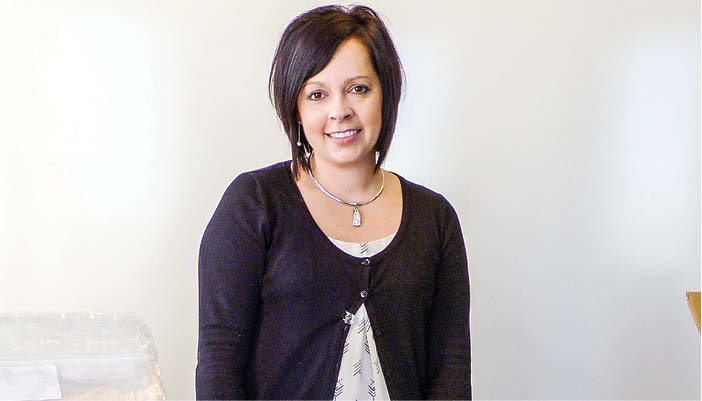When Moorhead voters go to the polls on Election Day, they meet a well-organized crew waiting to help them cast their ballots – a record number, if projections for 2016 voting hold true.
That’s because the city’s voters decided in 2014 to consolidate local voting, including the election of city council members, in even-numbered years along with state and federal elections. November’s balloting marks the first general election in which the entire range of offices are on the ballot.
Behind the orderly polling locations that will greet voters at 7 a.m. Tuesday, Nov. 8, is a largely invisible campaign executed long before the first yard signs and campaign flyers show up on the streets. Along with countless reams of printed pages, boxes of binders and the long line of luggage-like voting machines stored in City Hall’s basement, the preparations include recruiting and training a force of some 200 people who’ll staff voting places.
City Clerk Michelle French steers now-the biennial roll-out of ballot boxes to 15 polling locations throughout the city. She’s been working on next month’s big event since the Aug. 9 primary. Few contests led to very light turn-out then, when one location recorded only a single vote. This time around, she expects the numbers to be very different.
“We pull everything out and start all over again,” she says of the post-election procedure. “All the forms need to be updated. We restock all of our supplies. Right now we have rooms full of boxes here and at the county.”
The biggest job by far, though, is finding people to staff the 15 precinct voting sites. Ten to 14 men and women are needed at each location – most working from 7 a.m. to 8 p.m., but some on half-day shifts. Election judges greet voters and explain the process. They confirm that they’re on the roster of registered votes or, if not, help them register with the proper identification. They distribute ballots, show voters how to use the machines and finally distribute those ubiquitous flag-emblazoned “I Voted” stickers – a mark of pride on Election Day.
After the polls close at 8 p.m., the judgesy close down their voting places. Two co-head judges from each precinct accompany the ballots and machine results to the county auditor’s office in the Clay County Courthouse, where the results are ultimately certified and reported.
“It’s a 10-hour day for most of our people,” Michelle says. “The co-head judges spend more time at the courthouse.” In the general election in 2012, she remembers, they – and she — wrapped up a long, long day at about 2 a.m.
Who makes up the election crew? All kinds of people, she says, with one thing in common: They have the time to spend 14 hours or so making democracy work on an otherwise-unremarkable autumn Tuesday.
The majority – mostly women, with a scattering of men – are in their 50s, 60s and well beyond. “Many of them are the same people who are active community volunteers in the schools and churches,” she explains. Others are younger, including several who were recruited as 18-year-old high-school students in past elections.
Polling-place security is a non-issue here, Michelle reports. The most serious infractions – like wearing clothing with political sloganeering within 100 feet of the building – are easily corrected with a quiet suggestion to slip on a jacket or change clothes.
About half of the 100 judges scheduled for this election are hold-overs from past years, who brush up their knowledge of changing laws at two- and three-hour training sessions conducted by the county auditor.
“First we send out a letter to past judges to see if they’re interested,” the clerk says with a smile “Then I call and plead with those who don’t get back to me.”
It takes some creativity to fill the remainder of the slots. She starts recruiting newbies by word-of-mouth – first of all, asking every judge who comes to training whether they know just one more who might be interested in joining the team. She reaches out to the Moorhead Business Association, service clubs, and city boards and committees. She uses the media, too – not only news releases to TV and newspapers, but also Facebook and Twitter. City employees and police officers often volunteer to take a day of vacation to help out on Election Day.
Election judges are paid, but not much — $9.50 per hour, with head judges earning an extra dollar. Judges must be at least 18 years old, eligible to vote in Minnesota and fluent in written and spoken English. Judges can’t be married or related to any candidate on the ballot in that precinct. Once the precinct opens, they cannot leave until the end of their shift. Some veterans of past elections organize informal potlucks to keep body and soul together during the extended voting period, while others count on kindly spouses to bring in provisions.
Elections are an expensive proposition, Michelle notes. Between paying judges, renting voting sites in churches and other locations, and printing vast amounts of paperwork – training materials, ballots, binders full of detailed rules – the total outlay can amount to as much as $75,000.
At this point, Michelle – a Fertile, Minn., native and mother of four young children – declines to predict Nov. 8’s voter turnout. “The primary was horrible. We had less than 2,000 votes,” she says. “This is going to be a completely different story.” She expects a much more impressive number this time around, given the city’s population growth of almost 10 percent since the last presidential election, along with the addition of Oakport within the city limits.
“The county auditor has already received the highest number of absentee ballots ever,” she says. “We anticipate a huge ballot this time. We’ve added judges at all our polling locations, but it’s safe to say there are going to be some lines.”



